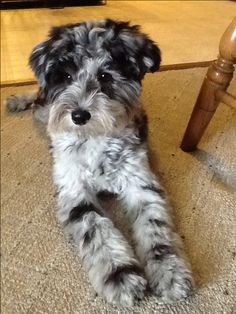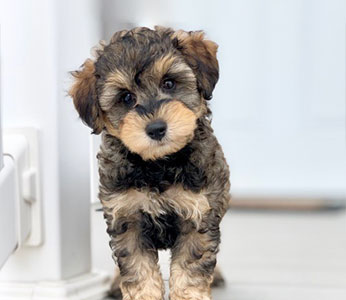Mini Schnoodle Breed Information


A cross between the Miniature Schnauzer and the Miniature Poodle, the Mini Schnoodle brings together some of the most desirable traits in a companion dog. Known for its hypoallergenic, low-shedding coat, the Mini Schnoodle is a popular choice among dog lovers, particularly those with allergy sensitivities. Beyond their physical appeal, these dogs are also highly intelligent and trainable, thanks to the strong genetic influence of both parent breeds.
Mini Schnoodles are adaptable to a variety of environments, whether it’s apartment living or a home with more space. Their social nature means they form close bonds with their families and are known for getting along well with children and other pets. These qualities, combined with their moderate size and exercise needs, make the Mini Schnoodle a versatile and popular family pet.
Characteristics
- One of the breed’s standout traits is its intelligence, inherited from both the Poodle and Schnauzer. Mini Schnoodle dogs are easy to train.
- Mini Schnoodles are affectionate and gentle. They fit well into families, especially those with young children.
- Mini Schnoodles have low-shedding coats and are often considered hypoallergenic. They are a good choice for families with allergy sensitivities.
- Ranging between 10-20 pounds and standing 12-15 inches tall, the mini Schnoodle adult’s size is ideal for various living environments.
- Despite their small size, Mini Schnoodles require regular exercise and mental stimulation to keep them engaged and happy.
- With proper socialization, Mini Schnoodle dogs adapt well to living with other pets in the household.
- Their Schnauzer lineage gives them a natural alertness and protective instinct. They make great little watchdogs.

Appearance
The Mini Schnoodle’s appearance is a carefully balanced blend of its parent breeds, offering both aesthetic appeal and functional advantages. Typically weighing between 10 and 20 pounds, with a height of 12 to 15 inches, Mini Schnoodle adults fall into a size category that is versatile enough for different living conditions. Their compact size allows them to fit well in apartments, while their strong, agile build, inherited from the Schnauzer, makes them equally suited for more active lifestyles in larger homes.
A defining feature of the Mini Schnoodle is its coat, which is usually wavy or curly, thanks to the Poodle lineage. The low-shedding, hypoallergenic nature of their fur has made this breed a popular choice for households with allergy sufferers. Their coat can come in various colors, such as black, gray, white, and brown, and some Mini Schnoodles even have multi-colored or parti-colored patterns. This variation adds to their visual charm, but their coat requires regular grooming to prevent matting and maintain its soft texture.
The Mini Schnoodle often exhibits characteristics of the Schnauzer, particularly the distinctive beard and pronounced eyebrows that give them an alert, expressive appearance. Their dark, intelligent eyes reveal their sharp minds and engaging personalities.
Temperament
The temperament of the Mini Schnoodle reflects the deliberate crossbreeding of two breeds with distinct, yet complementary, qualities. From the Schnauzer side, Mini Schnoodles inherit a strong sense of loyalty and a protective instinct. These traits make them vigilant watchdogs, particularly in new or unfamiliar situations, without being overly aggressive or reactive.
Their Poodle lineage brings high intelligence and a playful spirit. Mini Schnoodles are quick learners and enjoy mental challenges, which allows them to thrive in environments where they can engage in training, puzzle games, or interactive activities. Additionally, their affectionate nature allows them to form deep emotional bonds with their family members, which means they are excellent companions for both children and adults.
Care
Grooming
Grooming the Mini Schnoodle requires regular attention, given the breed’s characteristic low-shedding, curly or wavy coat. While this coat is often hypoallergenic, it can be prone to matting and tangling if not properly maintained. To keep their fur in optimal condition, brushing two to three times per week is necessary. This not only prevents matting but also stimulates the skin and distributes natural oils that keep their coat soft and healthy.
Nail care and dental hygiene are just as important as coat maintenance. Overgrown nails can lead to discomfort and injury, so trimming them every few weeks is essential. Additionally, brushing their teeth multiple times a week helps to prevent plaque buildup and periodontal disease, which are common issues in smaller breeds like the Mini Schnoodle.
Exercise Needs
The Mini Schnoodle’s exercise needs are indicative of their moderate energy levels and mental agility, both traits inherited from their Poodle and Schnauzer parentage. While their size might suggest they require only minimal physical activity, these dogs benefit greatly from 30 to 45 minutes of daily exercise. Whether through a brisk walk, structured playtime, or even agility courses, they need consistent physical outlets to keep them in optimal health. Their compact size allows them to adapt to urban environments, but regular outdoor exercise remains crucial.
Mental stimulation plays an equally important role in their overall well-being. The Mini Schnoodle is an intelligent breed that thrives on interactive activities. Owners can provide puzzle toys, engage in advanced obedience training, or incorporate games that challenge their problem-solving skills. Without sufficient mental challenges, Mini Schnoodles may become restless and turn to undesirable behaviors such as excessive barking, digging, or chewing.
Health
The overall health of the Mini Schnoodle tends to be robust, but there are a few mild health issues that should be monitored to ensure long-term well-being. One of the most common concerns is dental health. Small breeds like the Mini Schnoodle are prone to plaque accumulation due to the structure of their teeth. If left unchecked, this can lead to gum disease and tooth decay. Regular brushing and routine dental cleanings play a crucial role in preventing these issues and maintaining overall oral health.
Allergies are another area that some Mini Schnoodles may struggle with. These allergies can be caused by environmental factors such as pollen or dust, or they can be food related. Common signs include itching, red skin, or mild digestive upset. Identifying the allergens and adjusting their diet or environment can significantly improve the dog’s comfort and reduce allergic reactions.
Additionally, ear infections are a relatively mild but recurring issue for Mini Schnoodles, especially those with floppy ears. The structure of their ears can lead to moisture becoming trapped, creating a breeding ground for bacteria. Regular ear cleaning helps minimize the risk of infections and ensures that any early signs of discomfort are quickly addressed.
Lifespan
The Mini Schnoodle’s lifespan, ranging from 12 to 16 years, is a testament to its strong genetic foundation as a hybrid breed. Their longevity can be attributed to the careful blending of the Miniature Schnauzer and Miniature Poodle, both of which are known for their resilience and relatively long lifespans.
Training
The Mini Schnoodle’s training process is one that benefits greatly from its high intelligence and willingness to please. Both Poodles and Schnauzers are known for being quick learners, and their hybrid offspring follows suit. Positive reinforcement is particularly effective with Mini Schnoodles, as they respond well to treats, praise, and playful interaction. Starting basic obedience training early ensures that they pick up fundamental commands like “sit,” “stay,” and “down” efficiently.
However, Mini Schnoodles also require a consistent and structured approach to training due to their active and sometimes independent nature. Owners may find that their playful demeanor can lead to distractions, so it’s essential to keep training sessions short yet varied. Regular practice of commands ensures they remain focused, and incorporating mental stimulation, such as puzzle toys or agility training, helps to keep their active minds engaged.
Socialization is another critical aspect of the Mini Schnoodle’s development. Introducing them to a wide range of environments, people, and other animals from a young age reduces the risk of anxiety or fear-related behaviors in unfamiliar situations. Proper socialization, combined with consistent training, helps shape the Mini Schnoodle into a confident and well-rounded companion that can handle new experiences with ease.
History
The creation of the Mini Schnoodle can be traced back to the 1980s, when breeders started developing designer dogs by crossing two purebred parents to achieve specific traits. The Miniature Schnauzer and Miniature Poodle were selected for this particular mix because of their desirable qualities. The Schnauzer contributed a sturdy, loyal nature and a watchdog-like instinct, while the Poodle brought intelligence and a hypoallergenic, low-shedding coat.
The goal was to create a versatile, trainable dog that could thrive in various environments while also being suitable for people with allergies. The Mini Schnoodle quickly became a popular breed, thanks to its adaptability and affectionate personality. Today, Mini Schnoodles are widely recognized for their friendly disposition, sharp minds, and compatibility with children and other pets. Their success as a designer breed stems from the careful selection of traits that make them sweet little companions.




